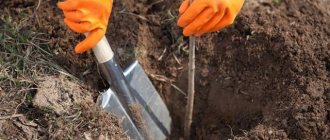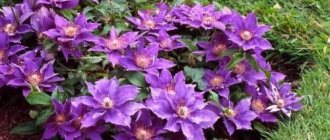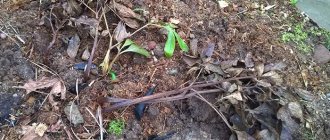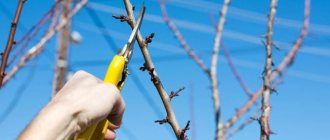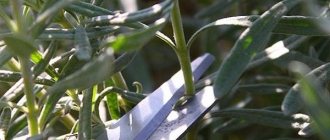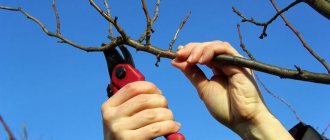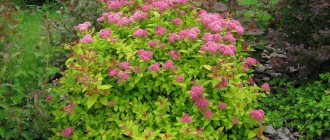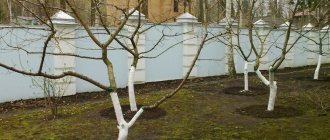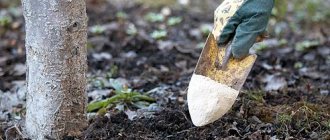Fruits and berries » Plum
0
257
Article rating
Kira Stoletova
Proper care of plums in the fall is the key to a good harvest for the next season. It includes a number of mandatory events within the time limits established for different regions.
How to care for a plum in the fall - basic activities
Trimming
The rapid growth of plums leads to nutrient deficiency and reduced fruiting. Pruning is a necessary part of preparing for winter. Removing excess growth and forming a crown helps not only prepare the tree for cold weather, but also promotes the proper development of stone fruit.
The timing of plum pruning depends on the agroclimatic characteristics of the region in which the plants grow.
In autumn, branches are pruned in the middle zone , when all the fruits have been collected and the foliage has fallen. In cold regions (in the Urals, Siberia), overgrown shoots are removed closer to summer.
| Features of plum pruning | |
| Age | Crown formation method |
| First year seedlings | Trimming the main trunk by 2/3, shoots by 1/3 |
| Two- and three-year crops | Thinning, shortening the shoots by 30–40 cm above the top branch (ensures the straightness of the main trunk), pruning long branches by a third, and side shoots to 15 cm |
| Fruit trees | Removing dry, diseased and broken branches, shortening the elongated central conductor, pruning fast-growing shoots |
ATTENTION! To prevent young shoots from growing back, they should be dug up along with the roots.
Before winter, shoots should be thinned out and shortened at least twice during the fall. The last time the branches are pruned is just before the onset of cold weather.
How and why you need to care for plums at the end of August and autumn
The main goal of the gardener in the fall is to help the fruit tree painlessly survive the phase of relative dormancy. Despite the fact that in the autumn the growth of the above-ground part of the plum stops, the active development of the root system continues.
Complex physiological processes take place in tree structures to prepare for the winter period. The main accumulation of active substances occurs in the period after the completion of shoot growth before leaf fall.
The lignification of shoots, which means resistance to low temperatures, depends on the volume of these reserves. Therefore, moisture-recharging irrigation is very important; it is necessary to feed the plum tree in the fall .
In summer, especially at the end of August, the number of many plum pests reaches its maximum. Overcrowding and pesticide treatment in other areas can cause insects to migrate to the fruit tree.
To prevent the growth of pest colonies at your dacha, the wood is treated with insecticidal agents . No less important for plum health is treatment with fungicides, this will prevent the development of fungal diseases in the spring.
Under the influence of cold, the flexibility of plum branches is lost. This leads to their breakdown under the load of winter precipitation or exposure to squally winds. Preventive pruning will help minimize injuries to the fruit tree.
Proper insulation of wood for winter will help you survive the winter cold and temperature changes . In addition, the plum tree needs protection from rodents, which are always active in winter in search of available food.
Pest extermination
When preparing for winter, pay special attention to inspecting plums for the presence of pests and their clutches. As a rule, for successful wintering, insects look for cavities in the bark and go into shallow layers of soil. They also leave clutches of eggs there. For prevention, the following measures are taken:
- cleaning the trunk circle from fallen leaves;
- removal of damaged bark, moss and other formations;
- pruning dried and diseased shoots;
- spraying the plant with insecticides.
Regular pruning of the crown, removal of root shoots, installation of traps and whitewashing of trunks get rid of overwintering colonies of insects.
Before treating plum trees with chemicals, get rid of the insects present on them.
First of all, shake off the pests. To do this, prepare the soil near the tree trunks by spreading old covering material. The main task is to cover the soil along the entire crown projection. Then they carefully shake off the branches, dropping the insects onto the covering.
Next, the damaged and dead bark and lichens are removed with a scraper. The cleaned surface is carefully brushed with a metal brush, trying not to touch healthy bark tissue.
Insects, collected foliage, removed shoots, and removed fragments of bark, lichens are burned outside the garden plot.
ATTENTION! To prevent the appearance of pests, the soil around the trunk is dug up onto the floor of the bayonet.
Spraying of plums is carried out in the second half of autumn at above-zero temperatures. To do this, prepare a 5% urea solution (500 g of the drug per 10 l).
- Time spending. In the morning or evening in dry, cloudy and windless weather.
- What is processed? Trunk with a central conductor, skeletal branches, side shoots.
- How is it processed? Copious spraying from a distance of 70 cm.
A small number of parasites are fought in a traditional way: by spraying with an infusion of onion peels, garlic and laundry soap.
To prepare the solution you will need:
- Garlic – 2 medium sized heads.
- Onion peel - 2 cups.
- Laundry soap – 40 g.
- Water – 5 liters.
Prepare the working solution as follows:
- Chopped garlic is mixed with dry onion peels.
- Add laundry soap, grated on a coarse grater.
- Boil water and pour into the prepared mixture.
- Leave the hood for several hours until it cools completely.
- Before spraying, filter the product through cheesecloth.
If the pests are resistant to the action of folk remedies, then a solution of Bordeaux mixture and ready-made purchased mixtures are used for destruction:
- Karbofos.
- Aktara.
- Nitrophen.
The process of planting plums in autumn
How often do we hear complaints from gardeners that planted plum trees for some reason do not bear fruit, or even die. And the reason lies not at all in a bad variety or low-quality seedling, it’s all due to improper planting.
Therefore, we strongly recommend that before the process of quickly and thoughtlessly burying a young tree in a prepared hole, you familiarize yourself with the main points of this simple but extremely important process.
The sequence of autumn planting of plum trees is as follows:
- First you need to choose the right place for future landing. Prefer a well-drained area of soil. It is desirable that it is also moisture-retaining. Attention! The selected area should be well lit and also have shelter from winter frosts.
- Thoroughly clear the soil of various weeds and thoroughly fertilize it.
- Now we move on to the next stage of preparatory work - the landing pit. The standard size is forty by forty centimeters. However, each seedling has its own special root system. The size of the planting hole depends on it. Visually determine the size of the rhizome and dig a hole in which the straightened roots of the young growth will be comfortably located.
- We take the seedling and carefully examine its roots , removing all damaged and crushed ends.
- We carefully lower the future fruit plant into the dug hole and begin to slowly cover it with earth. Make sure that the soil is distributed evenly without leaving any voids.
- Be sure to tie the seedling to a stake. This will protect him from adverse weather conditions during the first period of his life.
- Provide the plum tree with plenty of watering, it loves it very much.
If cold weather has set in and you have completely missed the time for autumn planting in the ground, there is still a way to preserve the seedlings until spring.
You can do this as follows:
- Fill the boxes with soil.
- Place the seedlings in them so that the young growth is practically lying down, and sprinkle its rhizomes thoroughly with soil.
- The boxes must be placed in a cellar or any other closed, cool place. It is highly undesirable to leave them outside.
If there is a greenhouse on your garden plot, then you can bury the young plants in it.
Top dressing
The time of flowering and fruiting exhausts the plants. In the autumn, despite the fall of leaves, the root system of most stone fruit crops continues to grow and develop. For this reason, fertilizing is a mandatory procedure when preparing plums for winter.
To get a good result, trees are fed a month before the onset of cold weather.
Organic fertilizers: humus or compost. Used to restore roots and accelerate their growth. Strengthens plant resistance to diseases and parasites. The application rate is 7...8 kg of humus per 1 m2 added to loosened soil.
ATTENTION! It is better to apply pig manure and bird droppings in the spring. A high nitrogen content will prevent the formation of flower buds and the ripening of the bark. As a result, in winter the young shoots of the plum tree will freeze.
Phosphorus-potassium fertilizers. Their action is aimed at improving productivity. Fertilizers are applied in dissolved form. Traditionally used:
- Potassium sulfate. For 10 liters of water take 2 tbsp. l.
- Superphosphate. For 10 liters of water take 3 tbsp. l.
In preparation for winter, per fruit-bearing tree, apply 30–40 liters of solution to the root soil in the first half of autumn.
Adult plums are fed by watering into grooves prepared 1.5 m from the trunk.
Young seedlings are watered with a ring at a distance of 15–25 cm from the trunk. Exceeding the dose of fertilizer leads to the death of the tree.
For dry application, the recommended rate is 30g per square meter. The use of phosphates is not allowed on sandy soils.
After fertilizing, the soil around the trunk is carefully dug up. The base of the trunk is not hilled.
Features of fertilization
Before applying fertilizers, the soil should be moistened. After the procedure, the soil is covered with compost. Straw is sometimes used, but do so with caution as it attracts rodents.
Plums younger than three years of age are fed with one-component solutions in the autumn, and complex formulations are chosen to fertilize plants older than three years.
Plum propagation methods
Any gardener dreams of learning the correct way to propagate plum trees. There are three main methods of reproduction:
- Overgrowth. It is necessary to prepare shoots in early spring, choosing the most developed shoot and digging it up. The height of the sprout should be approximately 20 cm, cut off the rest. Lubricate the cut with garden varnish to prevent infection. After this, we plant the shoots in a permanent location.
- Root cuttings. To dig cuttings, step back a meter from the trunk. Cut the workpiece into pieces of about 15–20 cm. Planting occurs in early May, only in well-moistened and loose soil. Plant the cuttings at a slight angle, ten centimeters apart. Cover the top with film, which must be removed after thirty days. Don't forget about regular watering.
- Vaccination. The best time to do this is when the buds are swelling. First you need to choose a cutting. Your future harvest depends on it. Ask your neighbors in your summer cottage, maybe someone has a beautiful plum tree growing. Ask for a small cutting. Then make identical cuts on the trunk of your plum tree and the new cutting. Bring them together tightly and tie them carefully using thread or burlap (any material at hand). Now all that remains is to wait for green leaves to appear on the shoot. This means that the vaccination was successful. Attention! As soon as young leaves begin to grow on the grafted section, you should cut off all the old branches. This will help the new shoots grow and develop better.
Methods of protection against rodents
In frosty, snowy winters, the bark of young seedlings is a real treat for rodents. During this period, visits from hares and mice and voles become frequent. Protecting plum trunks and shoots from wild animals involves covering and using deterrents.
To prevent rodents from damaging the bark, plum trunks are wrapped for the winter with one of the following materials:
- roofing felt;
- spunbond;
- fiberglass;
- elastic tape;
- burlap;
- nylon tights;
- spruce spruce branches;
- metal mesh.
For effective protection, rodent repellents are additionally used. You can prepare fragrant mixtures yourself or purchase them at garden retail outlets.
| Rodent protection products | ||
| Tree protection method | Characteristics of the method | Species of rodents |
| Repelling animals | Tying dark colored plastic bags to the branches of a fruit tree | hares |
| Mechanical barrel protection | Installation of a metal mesh fence along the diameter of the tree trunk circle. Digging into the ground around the trunk pieces of old pipes, buckets without a bottom, cut along the long side. Tying the root part of the trunk with roofing felt, burlap or iron mesh, similar to chain mail. Attaching the legs of spruce crops with the needles down to the trunk with a rope | hares, mice |
| Treating the trunk with an odorous mixture | Coating the trunk with a similar mass of equal proportions of clay and fresh cow dung with creolin (50g/10l of water) | hares |
| Fence installation | Construction of a fence around a plum tree using scrap materials with wide slits | hares |
| Using repellent mixtures | Place sawdust near the tree trunks, soaked in a solution of 5 g of creolin or carbolic acid in 1 liter of water | mice |
| Use of aromatic plants | Laying bunches of coriander sprigs, peppermint or cilantro under the plum | mice |
ATTENTION! Ruberoid is used with caution, since this material does not allow air to pass through and quickly heats up in the sun, which leads to the trunk rotting and peeling of the bark.
What else to do
How to prune a plum tree in the fall
The appearance of aphids in my case is associated with the massive spread of garden ants. The drugs helped, but only for a while. We had to resort to additional measures: to destroy them. Additionally, in the spring I set trap belts, destroying pests mechanically.
Even schoolchildren know that birds are natural enemies of insects. And gardeners happily “forget” about this. Dousing a tree with chemicals is easier than adding bird food in winter. I repeat, the situation in the garden is out of control. I usually try to manage with conservative methods. This time it didn't work out.
I am finishing my story. What do you say, dear like-minded people, was the game worth the candle? What are you used to treating trees with? Do you think folk recipes have lost their relevance? Leave comments here, write on social networks, share the link with friends. The topic is interesting, and a fresh look at the problem is needed. This is where I say goodbye, but I promise to return. Agree, we have something to discuss!
Comments
The blossoming of a plum tree is no less beautiful than the anticipation of the sweet and sour fruits that the tree will produce. In order for the fruiting period to be successful and with maximum benefit for the gardener, it is necessary to spray the plum after flowering. You will learn what and how to carry out the procedure by reading today’s article.
How to spray a plum after flowering?
After flowering, most fruit trees, in particular plums, need foliar feeding - spraying with solutions.
Plum treatments begin from the moment the buds open, directly, during and after flowering. A constant spraying system protects the fruit tree from diseases and pests.
What affects the plum:
- Moniliosis
- Clusterosporiasis
- Polystigmosis
- leaf roller
- codling moth
- Ticks
How to spray a plum after flowering:
- copper oxychloride (90%) 40-50 g per 10 liters of water.
- Insecticides: danadim (40%), zolone (35%), sumithion (50%), fufanon (57%) at 1-2 l/ha.
How to spray plums against pests after flowering?
At the end of flowering, a disaster happens to the plum - pests climb the tree in battalions, feeding on its life-giving juices. Instead of directing all its forces to the formation of additional ovaries, and then fruiting, the plum spends them on fighting uninvited guests. Let's take a closer look at what and how to spray plums against pests after flowering.
Fruit mites on plums - what to spray with?
Fruit mites become active in the summer. Insecticides help control these small insects. In this case, pyrethroid drugs will not help.
How to spray plums:
- Fufanon
- Danadim
- Fitoferm
In case of mass casualty:
- Sunmite
- Neoron
- Nissan
- Apollo
- Demitan
- Omite
Plum aphids - what to spray with?
First of all, treatment with a soap solution helps against pollinated plum aphids - which settle on the lower leaves on the inside. In case of mass infestation of plums by aphids, they resort to more radical measures than the folk recipe and mechanical removal.
What to spray:
- DNOC (1% solution)
- Nitrafen emulsion (2%)
- DDT oil emulsion (1%)
- Karbofos (0.15%) – after plum blossoms
Codling moths on plums - what to spray with?
Codling moths, seemingly harmless butterflies, must be eliminated immediately and mercilessly. They appear after the plum blossom period and actively “undermine” and rot the fruits of the tree.
What to spray:
Insecticides
Use pheromone traps to attract and capture codling moths during the active period, combine with clearing dead bark, loosening and cultivating row spacing, and pruning shoots.
Annual pruning and spraying of trees not only protects against diseases and pests, but also increases plum fruiting. It is advisable to carry out unscheduled disinfection of the plum tree bark once every few years with a 5% solution of copper (or iron) sulfate. Can be replaced with a solution of ash and soap:
- 2 kg ash
- 50 g soap
- 10 liters of water
Gardeners often resort to treatment with clay mash, garden paste or varnish, but, regardless of the variety of approaches, it is necessary to spray and treat plums before and after flowering.
Please rate the material you read :)
(1
ratings, average rating:
7.00
out of 10)
Pre-winter watering and mulching
The need for winter watering, the features and time of its implementation depend on weather conditions. During dry autumns, plums require abundant irrigation. During the rainy season, watering is not advisable. In case of excess precipitation, grooves are made in the ground around the trunk, through which excess moisture quickly drains away from the ground.
- in areas where groundwater is deep, the soil is moistened from 1.5 to 2 m in depth;
- It is enough to moisten damp clay soils to a depth of 1 meter.
Plum crops are watered towards the end of autumn, when the foliage has already fallen. When watering one plant, about 35 liters of water are consumed.
To prevent moisture evaporation, as well as to insulate the root system, mulching is carried out - covering the soil surface with mulch. Burlap is used as a covering material.
A multi-layer burlap flooring is laid on the dug up soil, covered with plastic film on top and buried in soil. This root insulation allows you to retain the required amount of moisture in the soil.
What and how to treat the garden
Fungicides and insecticides are chemical preparations that are used for therapeutic and preventive spraying against fungal and bacterial diseases, as well as “harmful inhabitants” of trees and shrubs.
There are quite a lot of products for treating the garden in the fall against diseases and pests, and the packaging of each of them contains instructions for use and restrictions on their use.
A one to two percent solution of copper sulfate helps in the fight against:
- scab and rot on apple trees;
- spotting and moniliosis on cherries, cherries, cherry plums, plums, as well as gooseberries and currants;
- anthracnose, bacterial canker, spotty necrosis, mildew on grapes.
Treatment should be carried out using a sprayer after the leaves have completely fallen off.
One percent Bordeaux liquid is used on fruit trees against powdery mildew, scab on pears and apple trees, as well as fruit rot.
The solution is prepared from milk of lime and copper sulfate (1 kg of sulfate is diluted in 50 liters of water, and lime in the same amount of water, after which the two mixtures are gradually poured in and mixed together).
The solution can only be used in cool weather (without precipitation), since treating the garden in the fall against pests and diseases in the heat or rain can lead to plant burns.
A solution of soda ash with soap is an excellent remedy for autumn treatment against powdery mildew on gooseberries and currants.
The prepared product must be sprayed on the bushes after harvesting; several treatments can be carried out before the onset of cold weather (if necessary).
Spraying tree trunks with a diesel fuel solution. It is a fungicide and destroys the larvae of most pests that damage the bark of plants.
After spraying with diesel fuel, the caterpillars and larvae begin to suffer from suffocation and gradually suffocate.
Carbamide (urea) is an excellent remedy for controlling pests such as aphids, leaf rollers, honey beetles and flower beetles.
Also, when treating the garden in the fall, this type of fertilizer becomes an excellent fungicide that prevents plants from being damaged by most fungal and bacterial diseases.
If the ripping of fallen leaves is not planned for the winter, they must be treated with a urea solution, this will prevent pests from settling in plant debris for the winter, and pathogens will also begin to die under the influence of nitrogen fertilizer concentrate.
It is necessary to use a urea solution only in dry weather, since rain will wash away the concentrate and your efforts will be in vain.
Treating the garden in autumn against pests and diseases using slaked lime is one of the mandatory procedures, especially if the garden plantings are very young. You can whiten the trunks with a brush or sprayer.
With the onset of winter, it is necessary to regularly inspect the plantings and, if necessary, clear the trunks and tree trunks of snow cover (but not all the way to the ground).
This will avoid damage from rodents that may get into the mulch, branches or other material used to protect the trunks from hares.
Whitewash
An equally important step in preparing plums for winter is whitewashing the trunk and skeletal branches of the first tier. The effect of sunlight reflected from snow is detrimental to unprotected plants. The bark gets sunburned. Sharp temperature fluctuations from night frosts to daytime thaws provoke the appearance of cracks and frost holes in the bark.
Whitewash reflects sunlight, reducing the heating of the trunk and shoots. The reflective coating provides protection from both burns and cracking. Bleached trees are protected from insects hibernating under the bark.
Trees cleared of dead bark are whitened in dry weather conditions after the leaves have fallen. The operation is carried out at an air temperature not exceeding +3 °C.
Whitewash is applied with a paint brush, covering the entire trunk and the beginning of the skeletal branches with a thick layer. The composition should have a thick consistency and not flow down the trunk.
Before whitewashing begins, all damage and wounds on plum trunks are cleaned to healthy tissue, disinfected and covered with garden varnish.
To prepare garden varnish you will need the following ingredients:
- wax – 2 parts;
- rosin - 2 parts;
- vegetable oil – 1 part.
Wax and rosin are melted in a water bath, vegetable oil is added and mixed thoroughly. After cooling, the composition can be used to heal wounds.
Whitewash mixtures
The mixtures used for whitewashing contain three main components:
- White pigment (lime or chalk).
- Fixative (PVA, clay, milk, laundry soap).
- Antiseptic (copper sulfate, manure, chicken droppings).
The common composition for whitewashing includes clay, lime and cow dung in equal proportions. The mixture is supplemented with 200 or 300 g of copper sulfate, dissolved in 10 liters of hot water.
| Examples of whitewash recipes | ||
| № | Compound | Preparation |
| 1. | Lime, vitriol, manure (droppings), water | Add 200g of vitriol to one kilogram of lime. Add one kilogram of manure (litter) and eight liters of water. Stir and leave for one hour |
| 2. | Lime, vitriol, clay, cow dung, water | Dilute a little more than two kilograms of lime, one and a half bags of vitriol, one kilogram of clay, two shovels of cow manure with water in a 10-liter bucket, bringing the volume to 10 liters. Bring to a creamy state |
| 3. | Lime, vitriol, clay, water, glue | In 10 liters of water, dilute two and a half kilograms of lime, one kilogram of clay and 500 g of vitriol. Add glue to the composition about ten percent of the total mass |
The easiest way to whiten a plum trunk is to use whitewash. Paints that contain glue are more resistant to precipitation. There are paints on sale with the addition of an antiseptic.
ATTENTION! An important property of whitewash paint is the creation of a breathable paint layer.
Creating winter protection
Plum requires shelter for the winter. To do this, mulch or cover the root system with covering material. Burlap in several layers is used as it. Cover the top with polyethylene and sprinkle with earth.
Whitewashing the trunk helps protect the trunk from frost damage, cracking and burns when sunlight is reflected from snow crust. This also reduces the risk of insects remaining under the bark of larvae.
Pre-existing damage to the bark is cleaned to a healthy layer of wood, covered with a disinfectant and covered with garden varnish.
Whitewashing is carried out in dry weather after leaf fall at an air temperature of up to 3°C. Apply a thick layer with a brush to the entire trunk and bases of skeletal branches.
Regional features of autumn care
Preparing plums for wintering depends on the characteristics of the climatic zone. Thus, in Siberia, crops are insulated, regardless of their age. Feed and do not water during the winter to protect the roots from freezing.
In the Urals, plums of all ages are insulated. Moisturize and partially prune with the arrival of autumn.
In central Russia and Belarus, before the start of winter, it is necessary to water the plants, feed them, dig up the soil, fertilize and trim the branches.
Carefully completed pre-wintering of plums is the key to the yield of the next season. Therefore, appropriate care is especially important during the period after fruit harvest and before the onset of cold weather. When organizing preparatory work, they take into account the climatic features of the place where the crop is grown, weather conditions and the age of the plum trees.
We cultivate the garden in the fall
Hello everyone, dear friends! The pre-winter period is very important to protect the garden from diseases and pests. Pests and pathogens must not be allowed to go away for the winter, to hide inside trees, shrubs, or in plant debris in the soil.
Autumn treatment of the garden against pests involves, first of all, the removal of weeds, fallen leaves, and cut branches. Plant residues are burned - this is the only way to destroy insect pests and pathogens that have prepared for hibernation. In addition, by clearing the garden of plant debris, you will destroy possible shelters for rodents.
All kinds of pest traps are removed from trees for the winter (and they are sure to be burned). The trunks of old trees are cleared of dead bark and lichens, and then whitened with chalk or lime. Autumn whitewashing, in addition to disinfection, protects trunks from frost damage (frost breaks), which subsequently facilitate the penetration of fungal diseases and pests into plants.
The signal for autumn processing of the garden is the fallen leaves of trees and shrubs (this is approximately the end of October - beginning of November). Choose a dry, frost-free day and spray apple and pear trees against scab. To destroy the causative agent of this disease, you need to use nitrogen spraying (it can be prepared by dissolving 500 g of urea in 10 liters of water). The solution is carefully treated with the trunk and branches of trees, fallen leaves, and soil.
Autumn treatment of the garden using blue spraying (Bordeaux mixture) is a good prevention against fungal diseases of pome fruits (apples, pears, quinces), stone fruits (cherries, plums, apricots), grapes, currants, gooseberries, etc. With the help of this spraying they fight against monilial burn, clasterosporiosis, coccomycosis, etc. For autumn spraying, a more concentrated solution is prepared than for spring, since there are no leaves on the trees that the solution can burn.
You can buy a ready-made 3% Bordeaux mixture or prepare it yourself. To prepare a 3% composition of Bordeaux mixture, you need to take 300 g of copper sulfate and 400 g of slaked lime and dissolve it in 20 liters of water. Bordeaux mixture can be replaced with Burgundy.
The method of preparing the Burgundy mixture is the same as the Bordeaux mixture, but instead of lime it contains soda ash. To prepare a 3% Burgundy mixture, you need to take 300 g of copper sulfate and 250 g of soda ash. To make the solution stick better to the plants when spraying, add laundry soap dissolved in hot water (soap cannot be added to the Bordeaux mixture, as it causes the solution to “curdle” into insoluble lumps).
Even if your garden is young and healthy, autumn treatment of the garden against pests and diseases must still be carried out; do not ignore the procedures for its protection - prevention is the best treatment.
See you again!
List of tools and materials
If the garden is young, one pruner is enough for it
To prune a plum tree, you need high-quality and well-sharpened tools:
- Secateurs for branches up to 25 mm thick. The bypass model is good for living branches, the model with an anvil is good for dried ones.
- Lopper for branches up to 50 mm thick in hard-to-reach places. Long handles will allow you to penetrate inside the thickened crown.
- Small and large garden saw (hacksaw) for branches thicker than 50 mm (dead and dry)
- Garden knife for burrs and irregularities.
Cuts and cuts need to be treated with garden varnish - prepare it in advance.
Winter green manure - a warm blanket and nutritious fertilizer for plums
Green manure is a universal fertilizer for plums that you can grow yourself. To do this, you can sow winter peas, barley, and wheat in the tree trunk circle in the fall. They can be planted under trees within a radius of 1-1.5 meters, or the inter-row space can be sown. To increase the fertility of garden soil, everything will be fine.
Experts recommend using a vetch-oat mixture. The green mass tolerates frost well and reliably covers the plum roots from freezing. After the snow melts, the green manure is mowed down and buried in the ground. You can do it even simpler - cut the plants and sprinkle a layer of garden soil on top. This is exactly how adherents of organic farming deal with green manure.
Digging the soil
Digging is done only after the plum tree has dropped all its leaves.
This procedure is:
- in applying the necessary fertilizers (approximately at a distance of 1 meter from the tree):
- in digging up the soil to a depth of 10 to 15 centimeters.
Important point : be sure to hold the shovels with the edge facing the bush.
Recommended fertilizers:
- humus in quantities from 10 to 15 kg;
- superphosphate about 100 g;
- wood ash from 300 to 400 gr.
You can add a little urea (no more than 40 g).
Note : digging is allowed no earlier than in the second year of the plum’s life.
Root zone care
If in the summer numerous pests were noticed on the plum tree or the tree was sick, it is better to hold off on digging up the trunk circle in order to easily rake and burn all the fallen leaves. If the tree is completely healthy, you can dig up the ground underneath it much earlier, when you have free time: fallen healthy leaves won’t hurt, earthworms will happily process them. If at the time of digging there are still vegetative weeds left, it is better to pull them out, and carefully dig up perennial weeds along with the roots.
Along the edges of the periphery of the crown, the digging depth can be 25–30 cm, closer to the trunk - no more than 5–8 cm. It is better not to dig the soil around young trees (1–2 years after planting), it is enough to loosen it with a hoe. Autumn mulching plays mainly the role of an insulating layer, so mulch is scattered under plum trees closer to the onset of frost. If moisture-recharging irrigation is necessary, it is better to scatter the mulch after it is carried out. The layer can range from several to 20–25 cm (depending on the region).
Many bulk materials can be used as mulch
Autumn marathon
What are the advantages of spring work? Is it rational to shift the deadlines to autumn? March and April are the most favorable months. Insects are awakening from hibernation, their numbers are small, they have not yet had time to give birth to offspring. The plant does not have time to accumulate the toxins contained in the chemicals in its different parts. When harvesting at the end of summer, you can be sure that the fruits are environmentally friendly!
It is easy to reduce the number of branches affected by diseases at the stage of preparing the garden for winter. In early September, treatment with Bordeaux mixture is carried out against marsupial disease. To treat clasterosporiasis, take the same composition in a lower dosage (1% instead of 3%). To kill insects, I personally use mechanical methods - I dig up the soil and remove caterpillars by hand.
Protection of young plums and seedlings
Young trees are most susceptible to frost; they often become prey for rodents (mice or hares) in winter. Whitewashing the trunk serves as good protection against frost damage and March sunburn, but from severe frosts the trunks of young trees are wrapped by tying coniferous spruce branches or roofing material to them. In the latter case, it is advisable to add reflective foil. In cold regions, the youngest trees are covered more seriously: they set up a “hut” by constructing a frame of boards on which non-woven materials are stretched.
For the most capricious trees you have to build an individual “house”
Coniferous spruce branches perfectly protect trunks from rodents (nylon tights do not always protect against them). It must be remembered that mice usually make their way to trees under the snow (and therefore it is advisable to trample down the snow near the trunks), and hares can stand on two legs (therefore the height of the shelter should be about a meter).
Soap, garlic and kerosene
After the spring labors, I was looking forward to a calm, warm summer. It was assumed that I would spend the time waiting for the coming harvest. Not so! A colony of ants has firmly established itself in the area. In June, July and August we had to carry out unscheduled processing of stone fruits several times. I didn’t want to take up chemistry again. For aphids I prepared a saturated soap-kerosene solution and herbal decoctions. Below are some recipes:
- How to spray leaves in summer? Infusion of onion peel. Add a bucket of hot water to a glass of raw material and leave for 4-5 days.
- Laundry soap helps against aphids. A quarter of the bar is mixed with 100 ml of kerosene and 10 liters of boiling water.
- Periodically, I used garlic infusion for preventive purposes. For 500 g of crushed cloves, add 3 liters of warm water. I insisted for a week, filtered it, and stored it in the basement. Then, if necessary, I diluted about 60 g in 10 liters of water. To make the mixture stick to the leaves, sprinkle grated laundry soap.
- Aphids and weevils usually do not tolerate plants with a strong odor. In warm weather, young seedlings were treated with a mixture of soap and marigold leaves infused in water. Occasionally I used nettle decoction. I didn’t notice any particular effect.
